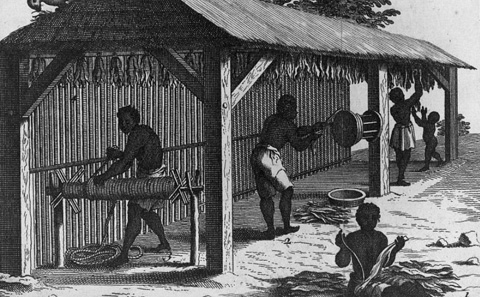
This 18th century engraving shows four people working with harvested tobacco in a shed.
Credit: Library of Congress
Slavery in Maryland
Grade 4, Grades 6–8
The first stage of Triangular Trade began in Europe. European goods were loaded onto ships bound for ports on the African coast in exchange for enslaved people. Europeans were looking for a more profitable way to harvest cash crops. Enslaved labor was cheaper than indentured servants.
In Africa, Europeans captured people and forced them to endure a brutal 5000-mile voyage to the Americas known as the Middle Passage. Enslaved Africans were transported to the Americas, sold, and were not paid for their work or treated humanely. This was the birth of the Transatlantic Slave Trade or the second phase of Triangular Trade.
In this lesson, students will learn how using enslaved labor led to beginnings of race-based slavery in the colony of Maryland.
Teacher's Guide and Related Standards
Students will be able to identify and explain the reasons why race-based slavery began in Maryland.
- Why did race-based slavery begin in the Maryland colony?
The Dig Clip
- What is the difference between an indentured servant and an enslaved person?
- Who benefited from enslaved labor?
- Why was enslaved labor important to them?
Vocabulary
Supplemental Enrichment Activities
Transatlantic Slave Trade
The Transatlantic Slave Trade transported between 10 million and 12 million enslaved Africans across the Atlantic Ocean to the Americas from the 16th to the 19th century. It was the second stage of Triangular Trade. Manufactured goods were shipped from Europe to Africa, enslaved people were shipped from Africa to the Americas, and raw goods were shipped from the Americas to Europe. Visit the Atlantic Slave Trade - Students | Brittanica Kids website to learn more about slave labor between Europe, Africa, and the Americas.
Labor in Early Maryland
Most Europeans traveled to the New World in hopes of better economic opportunities and more freedom. Farming cash crops such as tobacco became a brutal and very expensive business to maintain. To return a profit, European farmers looked for labor that would be cheaper and more constant than indentured servants. Read the Slavery Comes to Early Maryland: A Brief Look document to learn more about the origins of slavery in Maryland.
Enslaved vs. Indentured Labor
People who were enslaved were owned by another person. They were not considered citizens and did not have any rights. They were forced to work under grueling conditions and were frequently treated inhumanely by the people who owned them.
People who lived as an indentured servant often signed a contract to work for a certain period of time in a new place knowing their freedom was guaranteed at the end of their service.
Visit the two websites to analyze the images. What do you notice? What do you wonder about? What questions do you have? With a partner, discuss the differences of enslavement and indentured servitude.